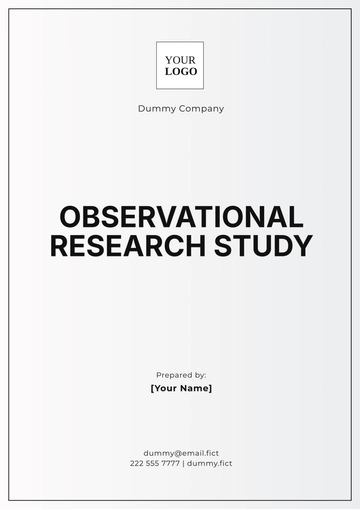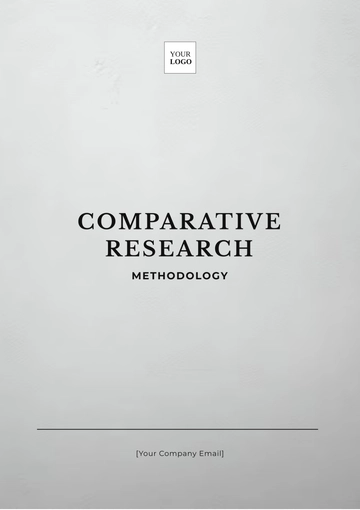Free Social Research Methodology

I. Introduction
This research methodology outlines a comprehensive plan for investigating the social dynamics and interactions within a particular community. The primary objective is to understand how social interactions influence the behavior and attitudes of individuals within this community. The research aims to provide insights that can inform policy-making, community planning, and further academic research.
II. Literature Review
The literature review synthesizes key research on social interactions and behaviors within communities, providing a foundation for understanding various influencing factors. The selected studies offer valuable insights into the dynamics of social interactions, community engagement, and behavioral patterns:
Smith, J. (2050). Community Dynamics and Social Interaction. Journal of Social Research. This study explores the intricate dynamics of community interactions, examining how social relationships and community structures impact individual behavior and group cohesion.
Doe, A., & Roe, P. (2051). The Impact of Social Networks on Community Engagement. Community Studies Quarterly. This research investigates how social networks influence levels of community engagement, highlighting the role of social connections in fostering active participation and involvement in community activities.
Adams, L. (2052). Behavioral Patterns in Urban and Rural Communities. Urban Sociology Review. Adams’ study contrasts social behaviors and patterns between urban and rural settings, providing insights into how different environments shape community interactions and individual behaviors.
These studies collectively address various factors shaping social behaviors, including socioeconomic status, educational background, and cultural norms, thereby offering a comprehensive understanding of community dynamics.
III. Research Design
The research adopts a mixed-methods approach, combining both qualitative and quantitative methods to provide a more nuanced understanding of social interactions:
Qualitative Methods: Qualitative methods will include in-depth interviews and ethnographic observations to gather detailed, narrative data on individual experiences and interactions within the community.
Quantitative Methods: Quantitative methods will involve structured surveys and statistical analysis to identify trends and patterns in social behavior across a larger segment of the community.
IV. Data Collection Methods
Data will be collected through several methods to ensure a comprehensive understanding of the research problem:
Surveys: Structured surveys will be distributed to a representative sample of the community to gather quantitative data on social behaviors and attitudes.
Interviews: In-depth interviews will be conducted with selected participants to capture qualitative data, providing deeper insights into individual experiences and social dynamics.
Observations: Ethnographic observations will be carried out in community spaces to observe social interactions in a naturalistic setting.
V. Sampling Strategy
To ensure a comprehensive and representative analysis, the study will employ two distinct sampling methods:
Probability Sampling: Random sampling will be used to select survey participants, ensuring that each individual in the community has an equal chance of inclusion. This method enhances the representativeness and generalizability of the survey results.
Purposive Sampling: Purposive sampling will be applied to select interviewees with specific characteristics or experiences relevant to the research. This approach provides diverse perspectives and deeper insights into social interactions within the community.
VI. Data Analysis
The data analysis will be thorough, adaptable, and effective in integrating both qualitative and quantitative data for a comprehensive review.
Quantitative Analysis: Statistical analyses, including descriptive statistics and inferential analyses, will be conducted using software such as SPSS or R to identify trends and correlations within the survey data.
Qualitative Analysis: Thematic analysis will be employed to identify recurring themes and patterns in interview and observational data, using software such as NVivo to assist with coding and thematic categorization.
VII. Ethical Considerations
Informed Consent: All participants will be fully informed about the study’s purpose, procedures, and potential risks, and their consent will be obtained before participation.
Confidentiality: We will ensure that participants' identities and data are kept confidential and anonymized to protect their privacy.
Non-maleficence: Measures will be implemented to ensure that no harm comes to participants, maintaining their well-being throughout the research.
Approval: Ethical approval will be obtained from the relevant Institutional Review Board (IRB) before the study begins to ensure compliance with ethical standards.
VIII. Limitations
Sampling Bias: There may be potential bias due to non-response or self-selection, which could affect the representativeness of the survey sample.
Temporal Constraints: The limited time available for data collection might restrict the depth and scope of ethnographic observations.
Resource Limitations: Financial and logistical limitations might affect how extensive and comprehensive data collection efforts can be.
IX. Conclusion
This research methodology outlines a detailed plan to investigate social interactions within a community, employing a mixed-methods approach to provide comprehensive insights. The combination of qualitative and quantitative methods, rigorous sampling strategies, and thorough data analysis techniques will ensure robust findings. Addressing ethical considerations and acknowledging potential limitations further strengthens the study's design. The insights gained from this research have the potential to significantly contribute to the understanding of social behavior and inform practical applications in community development and policy-making.
- 100% Customizable, free editor
- Access 1 Million+ Templates, photo’s & graphics
- Download or share as a template
- Click and replace photos, graphics, text, backgrounds
- Resize, crop, AI write & more
- Access advanced editor
Design impactful social research studies with our Social Research Methodology Template from Template.net. This customizable and fully editable template offers a comprehensive structure for planning and executing social research projects. From defining research questions to outlining data collection methods. Easily editable in our AI Editor Tool, it allows you to adapt the methodology to your specific research needs





























